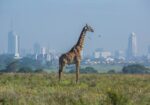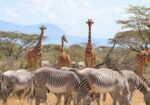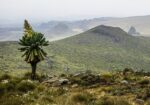Overview
Nairobi National Park, often hailed as the world’s only wildlife capital, is a unique safari destination conveniently located just 7 km from Nairobi’s central business district. Covering only 117 square kilometers, it is one of Africa’s smallest national parks but offers an unparalleled experience where urban life meets wilderness. A simple electric fence is all that separates the park’s rich array of wildlife from Kenya’s bustling capital. Visitors can enjoy game drives with a striking backdrop of city skyscrapers, while planes land and take off in the distance—a contrast that the animals appear completely unfazed by.
Attractions of Nairobi National Park
Wildlife
Home to four of the Big Five, Nairobi National Park may be small, but it boasts an impressive abundance of wildlife. The park is home to nearly 100 mammal species, making it a remarkable destination for nature enthusiasts and safari lovers.
One of the park’s greatest treasures is its population of rhinoceroses. These majestic, prehistoric animals once roamed widely across Africa and parts of Asia, but today their numbers have been drastically reduced due to poaching and habitat loss. Nairobi National Park now serves as a vital sanctuary, home to the world’s highest concentration of the endangered black rhino. This achievement has earned it the nickname “Kifaru Ark”—kifaru being the Swahili word for rhino—a tribute to its success in rhino conservation. For anyone hoping to see rhinos in their natural environment, few places on Earth offer a better opportunity.
Lions and hyenas are frequently spotted within the park, while cheetahs and leopards, though present, require a bit more luck and patience to find. Other animals regularly seen include gazelles, baboons, Rothschild’s giraffes, buffalos, Coke’s hartebeest, warthogs, waterbucks, wildebeest, zebras, and ostriches. Crocodiles can also be found in the park’s rivers, such as the Mbagathi River along the southern boundary, as well as in some of the seasonal wetlands and dams.
With its remarkable avian diversity, Nairobi National Park is a premier destination for birdwatchers. The park is home to around 400 bird species, offering year-round opportunities to observe and photograph both resident and migratory birds.
Resident species include impressive territorial raptors such as the martial eagle, African fish eagle, and augur buzzard, as well as secretary birds, often seen striding through open grasslands. Ground dwellers like the helmeted guineafowl, crested francolin, black-bellied bustard, and the Kori bustard—Africa’s heaviest flying bird—are also commonly spotted.
Colorful species such as the lilac-breasted roller, superb starling, and African grey hornbill add vibrant splashes of color to the landscape. Around wetlands and dams, you may encounter hadada ibis, African jacana, African darter, white-faced whistling duck, and grey heron. In the wooded areas, species like the common bulbul, speckled mousebird, and red-cheeked cordon-bleu are frequent sights.
From October to March, the park becomes a temporary home to migratory birds from Europe and Central Asia, including the Eurasian bee-eater, European roller, barn swallow, common kestrel, amur falcon, and steppe eagle.
Rare sightings that thrill even seasoned birders include the Abyssinian ground hornbill, African harrier-hawk, and the Jackson’s widowbird.
Ivory Burning Site
Conservation is a central pillar of Kenya’s national identity, and nowhere is this more powerfully symbolized than at the historic Ivory Burning Site, located near the main Langata Road entrance of Nairobi National Park. In 1989, Kenya’s second president, Daniel arap Moi, set fire to 11 tonnes of confiscated ivory here in a dramatic protest against rampant poaching that was decimating Africa’s wildlife. The bold act is widely credited with shifting global and local attitudes toward ivory trade and marking a turning point in Kenya’s conservation efforts. In 2016, former president Uhuru Kenyatta reignited the message by burning an even larger stockpile—105 tonnes of ivory and 1.35 tonnes of rhino horn. Today, the site features a monument, the ashes from the burnings, and a quiet lawn area with benches and public restrooms, now serving as a picnic and reflection spot. A visit here is both a tribute to Kenya’s enduring commitment to wildlife protection and a powerful statement against the ivory trade.
Nairobi Animal Orphanage
Just a short distance from the park’s main gate is the Nairobi Animal Orphanage, the oldest facility of its kind in Kenya, established in 1964. It serves as a rescue and rehabilitation center for orphaned and injured wildlife, offering care to animals that might otherwise not survive in the wild. Visitors can view a variety of animals up close, including semi-tame lions, leopards, cheetahs, hyenas, jackals, servals, and the rare Sokoke cat. Herbivores like monkeys, baboons, buffalos, and warthogs are also found here. The orphanage is home to several bird species as well, such as parrots, guinea fowl, crowned cranes, and ostriches. It’s a unique opportunity to see Kenya’s wildlife in a more intimate and educational setting.
Nairobi Safari Walk
The Nairobi Safari Walk is an elevated boardwalk trail within the park that allows visitors to experience Kenya’s rich biodiversity in a compact, accessible format. Designed to resemble natural habitats, the enclosures feature a range of wildlife including big cats, antelopes, primates, and rare species like the bongo, white rhino, and albino zebra. It’s especially popular with children, who enjoy getting closer to the animals than they typically would on a game drive. In addition to the wildlife, the Safari Walk showcases over 150 indigenous tree species, making it a valuable educational experience on both fauna and flora.
David Sheldrick Wildlife Trust – Baby Elephants
One of the park’s most beloved attractions is the David Sheldrick Wildlife Trust, renowned for its rescue and rehabilitation of orphaned baby elephants. It is the only place in Nairobi National Park where visitors can see elephants. The center opens daily from 11:00 am to noon, offering a memorable experience for guests. During the visit, caretakers lead the young elephants into a muddy viewing arena, where they are bottle-fed and then left to splash, play, and roll in the mud. Visitors can learn about each elephant’s rescue story and even opt to adopt one as part of the conservation support program.
Things to Do in Nairobi National Park
Game Viewing
Guided game drives offer an immersive way to explore Nairobi National Park’s diverse wildlife, all set against the unique backdrop of the city skyline. Visitors ride in 4×4 safari vehicles equipped with pop-up roofs for clear and safe wildlife viewing. Drives are typically scheduled for early morning or late afternoon, when animals are most active during the cooler parts of the day. For those looking for alternatives to vehicle safaris, the park also offers close-up wildlife experiences at the Nairobi Animal Orphanage or a more leisurely stroll through the Nairobi Safari Walk.
Bird Watching
With its rich and diverse birdlife, Nairobi National Park is a top destination for birdwatchers. The park is home to around 400 species, offering endless opportunities to observe and photograph rare and migratory birds throughout the year.
Picnics and Events
The park features several designated picnic and event sites, including the Impala Observation Point, Ivory Burning Site, Kingfisher Picnic Site, the Club House, and Mokoyiet Picnic Site. These locations provide scenic and serene settings perfect for weddings, bush dinners, team-building activities, corporate events, and family outings.
Adopt an Orphan
At the David Sheldrick Wildlife Trust, visitors can support conservation efforts by adopting an orphaned elephant, rhino, or giraffe for as little as US$50 per year. Whether for yourself or as a meaningful gift, your adoption helps provide food, care, and rehabilitation for the animals, while also supporting the long-term preservation of their natural habitats.
Best Time to Visit
The dry season is generally the best time to visit Nairobi National Park, as wildlife tends to gather within the park boundaries. This typically occurs from January to February and again from June to September, making animal sightings more frequent and easier. The short rainy season, from October to December, is also a good time to visit—the park remains accessible, and the rains bring a burst of greenery without significantly affecting game viewing.
The long rains, from March to May, can make safaris more challenging. Wildlife often disperses beyond the park’s borders, and some roads become muddy and difficult to navigate. However, this period also sees fewer visitors and offers lush, scenic landscapes for those who don’t mind a quieter, wetter experience.
For birdwatchers, the best months are from November to February, when migratory birds arrive from Europe and Central Asia, greatly increasing the variety of species visible in the park.
Where to Stay in Nairobi National Park
There are no lodges or hotels located inside Nairobi National Park itself. However, visitors can stay in privately run boutique lodges located along the park’s border. Notable options include Ololo Safari Lodge and The Emakoko, both beautifully situated on the banks of the Mbagathi River along the park’s southern edge, offering direct access to the park and scenic views.
While Nairobi Tented Camp was once located within the park, it is now situated in the peaceful, forested neighborhood of Karen, which remains conveniently close to the park and other attractions in Nairobi.
In addition to these, Nairobi city and its surroundings offer a wide range of accommodation options to suit every budget, from affordable hostels and mid-range hotels to high-end luxury stays.
How to Get to Nairobi National Park
The park is easily accessible from Nairobi’s city center, located just 7 kilometers away. The drive usually takes around 20 minutes, depending on traffic. For visitors arriving through Jomo Kenyatta International Airport, the main gate is about 16 kilometers from the airport and can be reached by road in 30 to 40 minutes, again depending on traffic conditions.
Nairobi National Park Safari Packages
Nairobi National Park is an ideal destination for travelers with limited time, offering a perfect opportunity for a quick yet authentic safari experience. Visitors can choose between half-day or full-day safaris, available for both individuals and groups. The park also fits easily into a broader Kenyan travel itinerary, making it a great stop before or after visiting other destinations. Additionally, it serves as an excellent venue for corporate team-building activities.
At Giorgi Safaris, we specialize in tailor-made Kenya safari holidays designed to meet every traveler’s needs and preferences. Our packages include expert guidance from professional safari guides, comfortable transport in well-equipped 4×4 vehicles, and carefully crafted itineraries that showcase the best of each destination, including Nairobi National Park and beyond. We work with trusted accommodation partners across all our featured destinations to ensure a smooth, enjoyable, and memorable safari experience from start to finish.
Conclusions: Why Visit Nairobi National Park
Nairobi National Park is truly unique—nowhere else in the world can you find a wildlife sanctuary located so close to a capital city. Here, visitors enjoy the rare sight of wildlife roaming freely against the dramatic backdrop of Nairobi’s skyline. Despite its relatively small size, the park is home to a rich variety of animals and birds, including four of the Big Five, endangered black rhinos, and a diverse population of both resident and migratory birds.
Popular attractions within and near the park include the David Sheldrick Wildlife Trust (home to rescued baby elephants), the Nairobi Animal Orphanage, and the Nairobi Safari Walk. Visitors can engage in a range of activities such as guided game drives, birdwatching, picnics, and even corporate events.
The park is a year-round destination. The best wildlife sightings occur during the dry season, when animals tend to gather within the park. The rainy seasons, on the other hand, offer fewer crowds and lush, scenic landscapes.
For accommodation, two boutique lodges—Ololo Safari Lodge and The Emakoko—sit along the southern boundary of the park on the Mbagathi River, offering serene views and direct access to nature. In addition, Nairobi city offers a wide range of lodging options, from luxury hotels to budget hostels and camps, all within easy reach of the park.
Nairobi National Park safaris can be customized to suit your schedule, whether you’re looking for a short half-day or full-day adventure, or planning to include it as part of a longer itinerary across Kenya.
Plan Your Safari Today
Ready to plan your Nairobi National Park safari? Contact Giorgi Safaris today to book your experience or get a custom itinerary tailored to your travel goals. We’re here to help you make the most of your time in Kenya’s most accessible and iconic wildlife destination.









